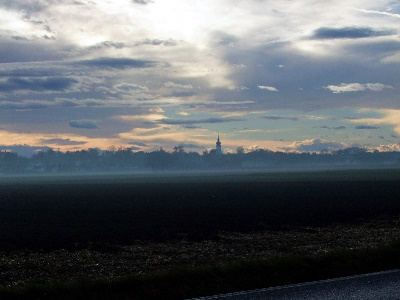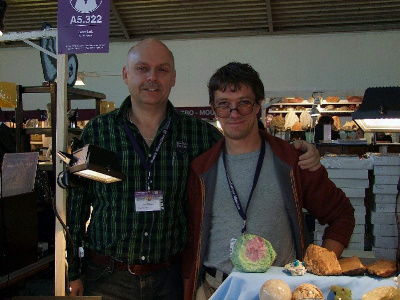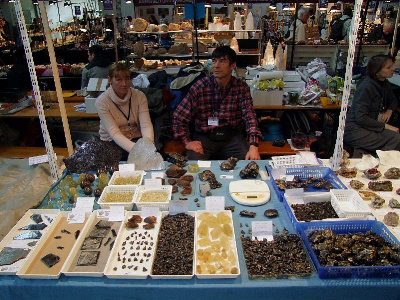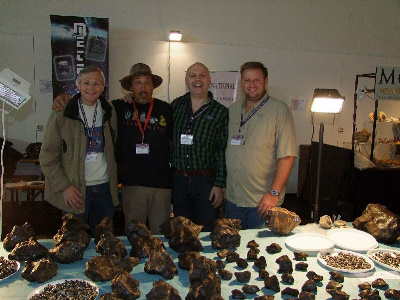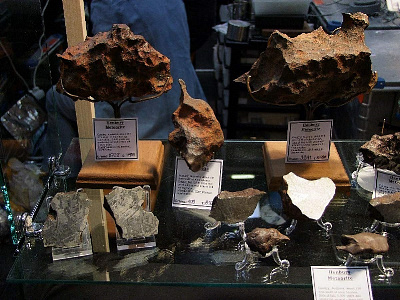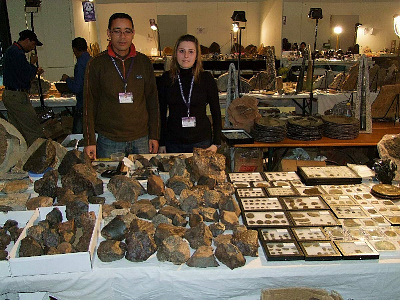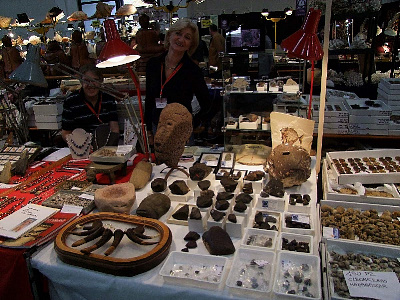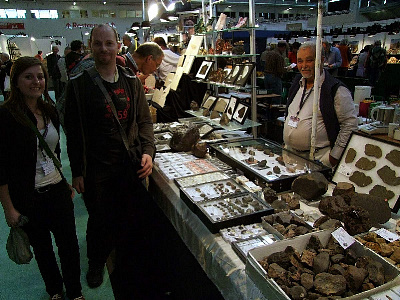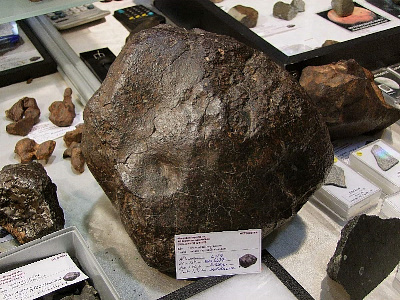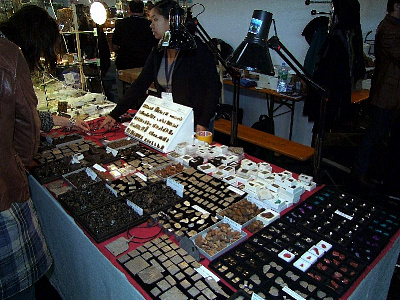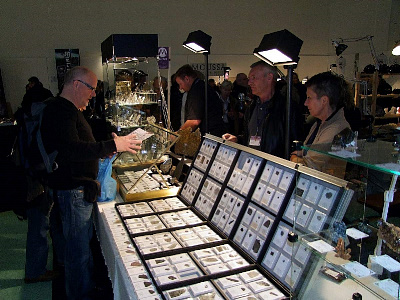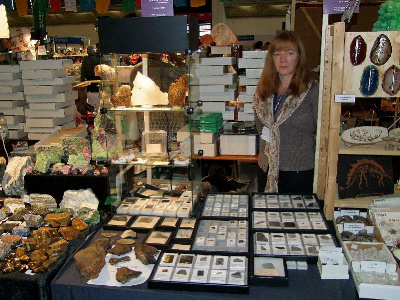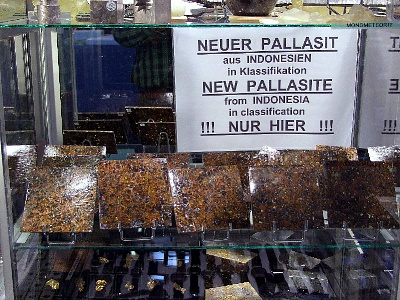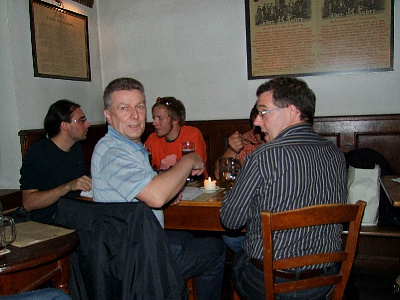IMCA Insights – November 2010
Munich Mineral Show 2010
by Martin Altmann
Autumn – time for the
big Munich Show.
Together with Tucson the marker, the indicator for the meteoritical
course of the following year.
Warm fall winds bestowed days of sun and pushed the panorama of the Alps
closer to the city. Full of expectations and pleasant anticipation,
having 70 exhibitors listed with meteorites in mind, the visitor entered
the halls. Though the longer he walked through the rows of tables, the
sharper he pressed together his pupils for his hunting scheme: dark,
brown, black, amorphous, lumpy, not colorful, not shiny – the more
perplexity crawled up his back. And the darker the clouds got over the
horizon.
Countryside near
Munich, early morning
Photo courtesy Hanno Strufe
Where are the
meteorites?!?
With this outcry as title and as a résumé the Munich report 2010 would
be completely done.
To give any impressions, we have to take leave from comparing with the
shows of the previous years.
So let's start with the irons.
The veteran iron, the Campo of earlier decades, when “meteorite” was a
synonym for Gibeon, has after 10 years of prohibition fully disappeared.
The last small box of the world with a few rough specimens was found at
the table of Granddaddy Karl Sprich. Prices quadrupled from the times,
Gibeon still was free.
Sikhote-Alin is exhausted: 4-5 small flats with small shrapnels, and
prices higher than those early ones, when you still could pick out
handfuls of bullets, buttons, drops, propellers bursting of flow lines
by the dozen from such boxes. Only three somewhat larger pieces on the
whole show.
The stalls of all our Russian friends together shrunk to a combined
length of 3 yards. On their tables, as well as on Bohemian Simek's, we
missed almost all we always were used to seeing: Brahins, Chingas,
Seymchans.
Hanno Strufe and Dima
Sadilenko (Cometshop)
Photo courtesy Hanno Strufe
Table of Viacheslav
Kalachev
Photo courtesy Hanno Strufe
Gebel Kamil – after the
furious impact in Ensisheim, it seems fully volatilized again. Only a
few specimens here and there and a modest box under the table. As small
comfort for the disappointed collector, at least a few small etched
slices at a very affordable 2-3$/g were available. Morasko? Nil return.
The only constant – like on every show – was of course ever-smiling Hans
Campo Koser with his hundredweights of Campo del Cielos in all sizes and
shapes. While the visitor lost his smile, when he remembered that two,
three years ago, still other prices were noted on the price tags.
Dieter Heinlein, Hans
Koser, Hanno Strufe and Mike Farmer
Photo courtesy Hanno Strufe
The silicated NWA-iron
wasn't available anymore in entire pieces.
Badly missed were all our Australian friends.
The bright spot, the Davidssons with a set of exquisite Henburys with
perfect patina and excellent shapes, some even resembling Sikhote-Alins.
One has to go far back in time, to remember to have seen, such an
assemblage of such museum-quality Henbury.
The Davidssons had a
lot of first class Henbury irons for sale
Photo courtesy Hanno Strufe
Iron of the season was,
like last year too: Muonionalusta.
All sizes, big, complete or etched. Cleaned or with yellow find patina.
Cheap! Leprechaun Dima Sadilenko took the collector by the hand to lead
him to Koser's stall, where he had to place a Muonionalusta, because it
was larger than his table. A whopping 630kg, big enough to fulfill the
dream of taking a ride on a meteorite.
Let's get over and done with the most dismal chapter: The desert
meteorites.
Who would not dwell about the past years, where even two out of three
fossils dealer hadn't enough space on their tables to place their
meteorites by the box – when he saw that disaster of that Munich weekend
2010. Nothing but perhaps 5 or 6 small shoe boxes, full of lousy
fragments.
Beat Booz from
Switzerland visiting Hanno Strufe at Ismaily's table
Photo courtesy Hanno Strufe
Ismaily and Eva
Photo courtesy Hanno Strufe
The best selection of
UNWA OCs was still on Ismaily's table, he had also the only (!) useable
oriented stone left of the whole show with its 1250 exhibitors. He
shared the table with Hanno Strufe, who presented a nice selection of
various desert types and his LL-metachondrite there.
Ahmed Pani belongs to the inventory of the show, although he's
specialized in hot desert, this time he had some fantastic distorted
Seymchan slices, as they would have been cut from a shrapnel with
olivines that popped in the eye of the visitor.
Of course the Tomerellis where there too – this time displaying mainly
pre-NWA-OCs of convincing quality, some of them shaped like artifacts.
Table of Giorgio
Tomelleri
Photo courtesy Hanno Strufe
But the award of the best desert assortment has to go this time definitely to Ali and Mohammed Hmani, comforting to see that the tradition is going from the father to the son to be continued.
Eva and Bernhard
looking at Ali Hmani's table
Photo courtesy Hanno Strufe
They brought the fine main mass of the last years find NWA 5960, the green-skin shergottite paired to NWA 2990 to the show and placed it in the show case next to a 118g-lunar from the 2995/2996er-series which is currently under classification.
A new lunar from Ali
Hmani
Photo courtesy Hanno Strufe
A 21 kilo large CV3
from NWA
Photo courtesy Hanno Strufe
The 20kg-CV3, which we
still know from Ensisheim was slumbering mighty on the table. A not yet
identified larger iron from the Ziz-field built the counterpart. From
their other delicacies, a fine fresh lunar-looking eucrite, coming in
many individuals is to mention and three jewels from Wabar. The ladies
of the harem must have a lot of sorrow – the tears they cried were large
as grapes!
Novelties from the hot deserts?
No new unpaired Martians and Lunars at all. No new finds from Oman at
all.
Only three larger HEDs, one 2kg fresh crusted eucrite with white
interior, a fragment of 4kg with oriented regmaglyptes of a HED and
another polymict one. A small handful of other HEDs, difficult to say,
which were really new or are later to pair to already known material.
And – shocking – that was all.
Prices? It's better to remain silent, for not depressing the reader
further.
Now to give a positive turn: the offers of historic finds and falls were
this year: excellent.
Eisler junior, the only dealer aside Mike Farmer, who hadn't shied away
from the long journey from U.S. this year, had a lot of pallasite slices
and a good variety of known and not so known names – for every purse.
Table of Bud Eisler
Photo courtesy Hanno Strufe
The palm, Achim & Moritz Karl took it, with adjacent Mike Farmer, who made up a museum out of their row. The Karls, when asked “what's new?”, modest as they are, answered: “Nothing”. But the slices of the historics you saw there and the names, drove tears in the eyes of the veteran collectors, let the beginners hectically search in the Blue Book, and the mid-term collector pause, to doubt in their belief that such names would be available only in molecular sized microspecks. Impressively the Karls cemented once again their position as dealers #1 of historic pieces. Mike Farmer's best new goodies were some Springwaters from his new finds, among them a really cute perfect individual.
Morten Billet at the
table of Achim Karl
Photo courtesy Hanno Strufe
Achim and Moritz
Karl's meteorites
Photo courtesy Hanno Strufe
The same line of remarkable historical locales followed as always Sergey Vasiliev. His advantage is, that he has always many budget-sizes too. Remarkable this time, a well-sized fusion-crusted Ivuna, usually horribly difficult to get.
Table of Sergey and
Elena Vasiliev
Photo courtesy Hanno Strufe
Positively to remark,
was this years enlarged availability of Impactites and tektites. Finally
again black indochinites of all sizes and shapes were basket-wise
offered (<30$/kg). And also the choice of moldavites was better than
ever. Here to mention expert Thomas Dehner, who also just has edited a
new book about moldavites. Good larger quantities, just like last year,
of Libyan desert glass were offered too.
No good show without out a novelty.
So as poor as Munich was, at least veteran dealer Uwe Eger rescued the
event in this respect this year. He displayed extremely thin slices of a
new pallasite from Indonesia. With strangely small orange olivines and
almost no metal in between. A find of reportedly 750kgs – under
classification.
The new Pallasite
from Indonesia presented by Uwe Eger
Photo courtesy Hanno Strufe
The character of Munich
2010 wasn't only the lack of meteorites, but also the absence of many
meteorite dealers. Only two dealers came from USA, the meteorite
offerers of Australia and Poland stayed completely home, and a lot of
the sounding European names were missing: Erich Haiderer, Alain Carion,
Chladni's Heirs, Siegfried Haberer, Bruno Fectay, Luc Labenne, Andi
Gren…
After the Fliegerbräu surprisingly had shut down, Andi Koppelt organized
the Friday Evening Come-together in the time-honored inn, the
Fraunhofer, with rustic traditional food, Munich beer, an atmosphere of
Gemuetlichkeit (and with a much better service and prices). It was nice
there, about 20 meteorite people tested it and were so content, that
this new location will be from now on the new Jour fix for the Munich
show.
Francesco Moser, Beat
Booz, Peter Marmet
Photo courtesy Hanno Strufe
Andreas Koppelt,
Jürgen Nauber,
Mary and John Kashuba, Mark Vornhusen
Photo courtesy Hanno Strufe
All in all Munich 2010
was for the meteorite collector a true shock. By far the poorest show
for meteorites of the last 10 years. Nevertheless, Munich, Ensisheim,
Tucson remain the three large MET-events where those
interested in those guests from space, will get so many meteorites in
their hands like nowhere else. Therefore these three Shows will always
be worth the visit.
Skol.
Martin Altmann
IMCA Director
This article has been edited by Anne Black and Norbert Classen
•
IMCA Home Page •
IMCA Code of Ethics •
IMCA Member List
•
Join IMCA •
IMCA Meteorite Info
